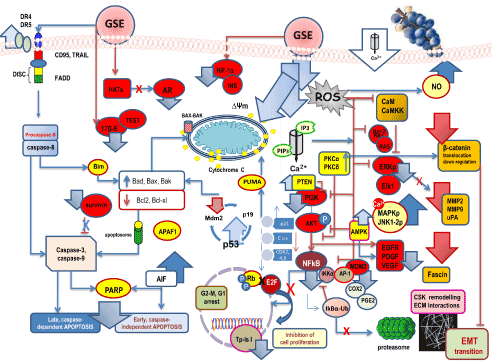
 |
| Figure 2: Molecular mechanisms of GSE interactions. GSE interacts with many cellular biochemical and genetic pathways, through which cell proliferation, cytoskeleton rearrangement, apoptosis and cell differentiation are modulated. A pivotal key-step is supported by the increase in ROS formation induced in cancer cells by GSE through the selective regulation of the redox balance. Acronymous: DISC, death-inducing signaling complex; FADD, Fas associated death domain; transmembrane death receptors, DR4, DR5; tumor necrosis factor-related apoptosis-inducing ligand (TRAIL); Insulin, INS; cAMP response elementbinding protein, CREB); poly-ADP-ribose polymerase, PARP; FOXO1, forkhead box O1; histone androgen acetyltransferase, HATs; Apoptosis Inducing factor, AIF; Apoptotic protease activating factor 1, APAF; Hypoxia-inducible factor 1-alpha, HIF-α; testosterone, TEST; Androgen receptor, AR; Inositol-3-phospgate, IP3; Phosphatydyl-Inositol-3-phosphate, PIP3; Calmodulin, CaM; Calmodulin kinase, CaMKK; PKC, protein kinase C; p53 upregulated modulator of apoptosis, PUMA; phosphatase and tensin homologue deleted on chromosome ten, PTEN; nuclear factor kappa B, NF-κ B; inhibitor of kappa B, IK-b (comprising the subunits IKKα,β,γ; Mouse double minute 2 homolog, MDM2; activator protein 1, AP-1; Nitric oxide, NO; urokinase-type plasminogen activator, uPA; matrix metalloproteinases,MMP2-9; Topoisomerase-I, Tp-Is 1; Prostaglandin-endoperoxide synthase 2 or cyclooxygenase-2, COX-2; prostaglandin E2, PGE2; 5’ AMPactivated protein kinase, AMPK; ETS domain-containing protein, Elk-1; cyclin, C; cyclin-dependent kinases, CDK; ubiquitination complex, Ub; cytoskeleton, CSK; extra-cellular matrix, ECM; epithelial-mesenchymal transition, EMT. |